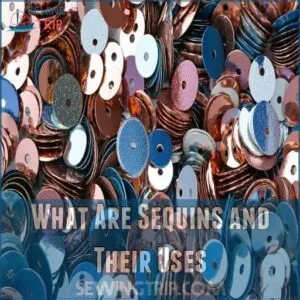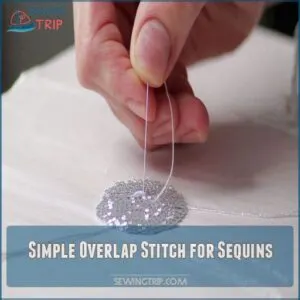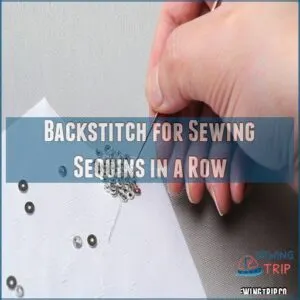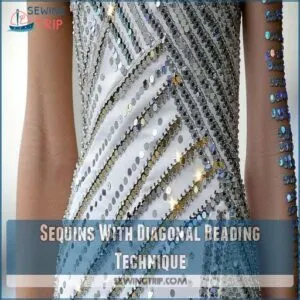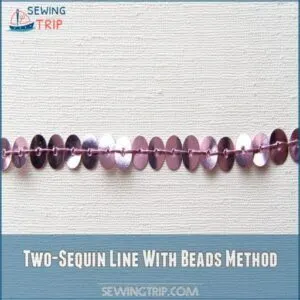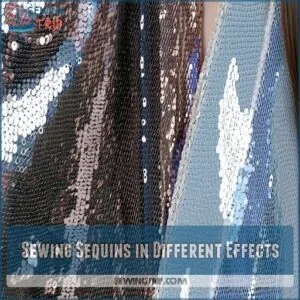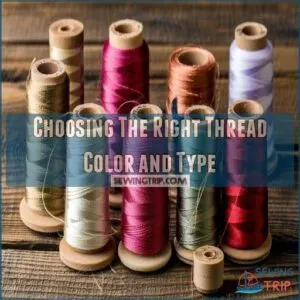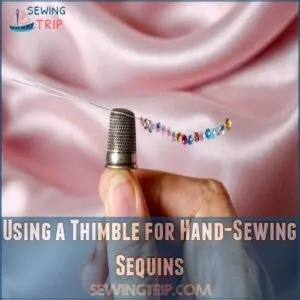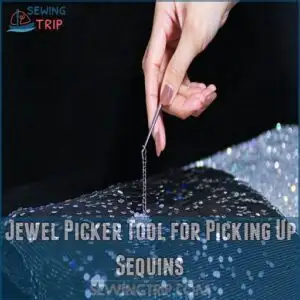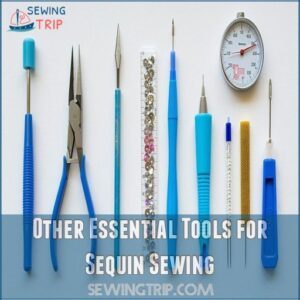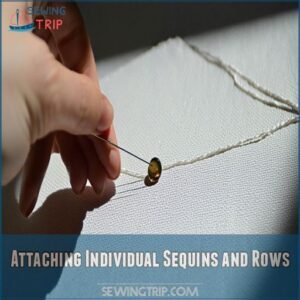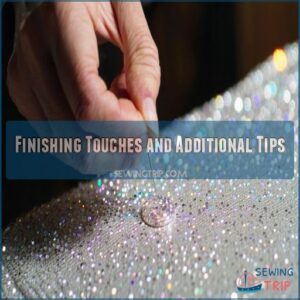This site is supported by our readers. We may earn a commission, at no cost to you, if you purchase through links.
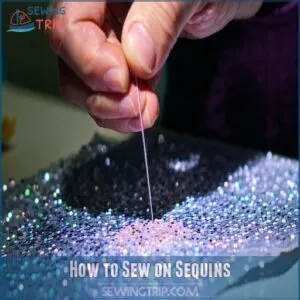 Want to learn how to sew on sequins? It’s easier than you think!
Want to learn how to sew on sequins? It’s easier than you think!
First, you’ll need sequins, thread, and a needle.
Decide where your sparkly friends will go.
Then, using a simple backstitch or even a knot, secure each sequin individually to your fabric. It’s a little like building a tiny, glittering mosaic!
Don’t worry about making mistakes—it’s all part of the learning process.
Remember to knot your thread securely at the end, otherwise, you’ll have a sequin-sized disaster on your hands!
For more advanced techniques and tips on creating stunning sequin designs, keep reading… you might be surprised at what you can create!
Table Of Contents
- Key Takeaways
- What Are Sequins and Their Uses
- How to Sew on Sequins
- Techniques for Hand-Sewing Sequins
- Sewing Sequins in Different Effects
- Materials and Tools for Sewing Sequins
- Attaching Individual Sequins and Rows
- Finishing Touches and Additional Tips
- Common Challenges and Solutions
- Frequently Asked Questions (FAQs)
- Conclusion
Key Takeaways
- Get the right tools: Use thin, sharp needles and match thread colors to your sequins or fabric for a polished look.
- Master basic techniques: Start with simple stitches like backstitch or overlap to secure each sequin with precision.
- Secure your work: Knot threads securely at the end to prevent sequins from coming loose and to ensure durability.
- Experiment with designs: Try different patterns, like overlapping or scattered sequins, to add unique textures and sparkle to your projects.
What Are Sequins and Their Uses
You’ll find these tiny, shiny disks called sequins on everything from princess dresses to party decorations, and they’re made of plastic or metal to catch the light and add sparkle.
Whether you’re jazzing up a plain t-shirt or creating a show-stopping costume, you can use sequins to transform ordinary items into eye-catching pieces that’ll make heads turn.
History and Cultural Significance of Sequins
Ever wonder why we’re so drawn to sparkly things?
The story of sequins goes way back – ancient Egyptians stitched gold discs onto their clothes, while King Tut’s tomb sparkled with thousands of gold sequins.
Through history, from Indian textiles to 1920s flappers and today’s red carpets, sequins have symbolized luxury and celebration.
They’ve evolved from precious metals to become the affordable sparkle we see today.
Materials Used to Make Sequins
From the glittering runways of Paris to your crafting table, sequins have evolved beyond their metallic origins.
Today’s sequins are primarily made from lightweight plastic materials like polyester, PVC, or mylar.
You’ll also find eco-friendly options crafted from recycled materials or biodegradable alternatives.
Some high-end designers still use traditional metal sequins, including aluminum, brass, or copper, for that classic luxurious shimmer.
Different Types of Sequins
A dazzling variety of sequins awaits your creative touch.
You’ll find them in countless shapes, sizes, and finishes that can transform any project into something special.
Here are three popular types you’ll love working with:
- Flat sequins: Perfect for beginners and everyday projects
- Cup sequins: Add dimension with their subtle curve
- Holographic sequins: Create stunning rainbow effects as they catch the light
Think of sequins as tiny mirrors – each type reflects light differently, giving your work unique personality.
Common Uses of Sequins in Fashion and Design
Sequins add that magical touch to everything they grace.
You’ll spot them stealing the show on bridal gowns and evening wear, but they’re not just for fancy occasions.
They’re making waves in streetwear, jazzing up denim jackets and sneakers.
Interior designers love them for pillows and wall art, while jewelry makers create stunning accessories.
Even your everyday tote bag can sparkle with a touch of sequin magic.
How to Sew on Sequins
You’ll love how sequins can transform your everyday projects into dazzling works of art with just a needle and thread.
These easy sewing techniques will help you attach sequins like a pro.
Whether you’re jazzing up a plain shirt or creating a showstopping costume, these easy sewing techniques will help you attach sequins like a pro.
Gathering Materials and Preparing for Sewing
Getting ready for your sparkly project doesn’t have to be complicated.
You’ll feel like a pro with the right setup and materials at your fingertips.
Before you start adding that magical shimmer to your fabric, let’s gather everything you’ll need:
- Flat workspace with good lighting
- Clean fabric, pressed and ready to go
- Organized selection of sequins in your chosen colors
- Sharp scissors dedicated to fabric cutting
- Small container to keep sequins from rolling away
Remember to give yourself enough elbow room – nobody likes chasing runaway sequins across the floor!
Choosing The Right Needle and Thread for Sequins
Picking the right needle and thread combo is like choosing the perfect dance partners – they’ve got to work together smoothly.
You’ll want a thin, sharp needle that glides through those tiny sequin holes without a fuss.
| Needle Type | Best For | Thread Match |
|---|---|---|
| Beading (10-12) | Tiny sequins | Fine thread |
| Crewel (9-10) | Regular sequins | Medium thread |
| Sharp (11-14) | Heavy sequins | Strong thread |
| Universal (12) | Basic projects | All-purpose |
Basic Techniques for Sewing Sequins
Learning to sew sequins starts with mastering three key techniques.
The basic stitch involves pushing your needle through the sequin’s center hole and securing it with a single stitch.
For overlapping, each new sequin covers the previous one’s stitches, creating a seamless look.
If you’re adding beads, thread them after the sequin for extra sparkle and security.
Similarly, when working with rhinestones, using the right fabric glue for rhinestones is essential for a strong hold.
Tips for Efficient and Secure Sequin Sewing
Everyone wants their sequins to stay put and sparkle.
Start by using thin needles (size 10 or smaller) to prevent fabric damage, and match your thread color to either the sequins or fabric for a polished look.
You can find the perfect sequin needle size for your project at a specialized store like sequin needle suppliers.
You’ll want to double-knot your thread and use interfacing on delicate fabrics to prevent puckering.
For extra security, try adding a tiny bead as a stopper – it’s a game-changer!
Techniques for Hand-Sewing Sequins
You’ll be amazed at how easy it’s to transform your clothing with hand-sewn sequins once you learn these go-to techniques.
Whether you’re adding a simple sparkly trim or creating an eye-catching pattern, these methods will help you sew sequins that stay put and shine bright.
Simple Overlap Stitch for Sequins
The simple overlap stitch creates that classic sparkly look you’ve seen on red-carpet gowns.
Start by bringing your needle up through the fabric, thread a sequin, and secure it with a stitch beside it.
For the next sequin, bring the needle up near the edge of the first one and overlap slightly.
This technique hides your stitches while creating a smooth, professional finish that’ll catch everyone’s eye.
Backstitch for Sewing Sequins in a Row
For a flat, snag-free line of sequins, the backstitch is your secret weapon.
Start by bringing your needle up through the center of your first sequin, then go down into the fabric beside it.
Pop back up a short distance away, thread on another sequin, and go down through the center of the first one.
Keep this rhythm going, matching your thread to your sequins.
Sequins With Diagonal Beading Technique
Ready to add some extra sparkle?
Building on what you’ve learned about backstitching, let’s explore diagonal beading – perfect for edging appliqué pieces or outlining motifs.
Start by bringing your needle up through the fabric, then thread on a sequin followed by seed beads. Go back down diagonally along your desired line. Keep repeating this pattern until you’ve created a stunning border that catches the light beautifully.
Two-Sequin Line With Beads Method
Moving beyond diagonal beading, let’s explore a dazzling technique that’ll make your projects pop.
By pairing two sequins with beads, you’ll create eye-catching texture that catches light from every angle.
Thread your needle through both sequins, add seed beads between them, and maintain consistent spacing for a professional finish.
- Choose beads that complement your sequins’ size and color
- Keep thread tension even to prevent puckering
- Space sequin pairs about 1/4 inch apart
- Test bead placement on scrap fabric first
Sewing Sequins in Different Effects
You’ll love how different sequin patterns can transform your projects from simple to show-stopping, whether you’re creating neat rows or playful scattered designs.
From overlapping sequins that mimic fish scales to free-form patterns that sparkle like stars in the night sky, you’ll find lots of fun ways to make your sequin designs truly shine.
Sewing Sequins in a Row (Side by Side)
Creating side-by-side sequin rows lets you achieve that eye-catching disco ball effect without any overlap.
Start by marking your fabric with guidelines to keep your rows straight.
Space sequins evenly using the width of your needle as a guide, and secure each one with a single stitch through the center hole.
Keep your thread tension consistent for a professional finish that’ll sparkle beautifully.
Sewing Sequins in a Row (Overlapping)
The overlapping technique gives your sequins that gorgeous fish-scale effect you’ve seen on designer gowns.
Start with your first sequin at the bottom edge, then place each new one so it covers about 1/3 of the previous one.
You can get a variety of sequin colors and types at a sequin sewing kit.
Keep your thread tension moderate – too tight and you’ll pucker the fabric.
Work in rows, maintaining consistent overlap size for that professional finish everyone will admire.
Sewing Sequins in Scattered Effects
Scattered sequin effects can transform any plain fabric into a dazzling masterpiece.
Start by marking random spots on your fabric with chalk or disappearing ink.
Space them closer together for dense sparkle, or further apart for subtle shimmer.
To prevent skin irritation from sequin chafing, consider wearing breathable fabrics like sleeveless leotards under your sequined costumes, which can be especially helpful in preventing skin irritation from sequins.
You’ll want to secure each sequin individually with a single stitch through the center hole.
Mix different colors or sizes to create depth and visual interest.
Creating Decorative Shapes With Sequins
From simple hearts to intricate butterflies, you can arrange sequins into any shape your imagination dreams up.
Start by sketching your design lightly on fabric, then place sequins along the outline.
For geometric shapes, use a ruler to make sure straight lines.
Try overlapping sequins in floral motifs for depth, or scatter them in animal silhouettes.
Abstract patterns work great too – just let your creativity flow!
Materials and Tools for Sewing Sequins
You’ll be amazed at how a few simple tools can transform your sequin sewing projects from tricky to terrific.
With the right needle, thread, and handy helpers like a thimble and jewel picker tool, you’ll be ready to add that perfect sparkle to any project.
Choosing The Right Thread Color and Type
Selecting the right thread can make or break your sequin project.
Choose thread that matches either your sequins or fabric – go with invisible thread if you want stitches to disappear completely.
For durability, pick strong polyester or nylon thread that won’t snap under tension.
Match thread weight to your sequin size: lighter threads for delicate pieces, medium-weight for standard sequins.
Using a Thimble for Hand-Sewing Sequins
A thimble is your best friend when hand-sewing sequins – it’ll save your fingers from countless pin pricks! Just like finding the perfect pair of shoes, you’ll want a thimble that fits snugly on your middle finger.
Here’s what to look for in a sequin-sewing thimble:
- Metal thimbles with deep dimples grip needles better
- Leather thimbles offer flexibility and comfort
- Adjustable thimbles work well for changing finger sizes
Jewel Picker Tool for Picking Up Sequins
A jewel picker tool feels like having a third hand when you’re working with sequins.
This handy wand uses either wax or a tacky tip to lift and place sequins exactly where you want them.
You’ll find it’s a game-changer for precise placement, especially with tiny or cup-shaped sequins.
Just touch, lift, and position – it’s that simple.
Plus, it keeps finger oils off your sparkly pieces.
Other Essential Tools for Sequin Sewing
Beyond your jewel picker, you’ll want a few more tools in your sequin sewing kit.
Keep sequin pliers handy for gripping stubborn needles.
Grab a sewing gauge to measure spacing perfectly.
A fabric marking pen helps map out your design, while a seam ripper’s there when you need a do-over.
Don’t forget beading needles – they’re slim enough to glide through those tiny holes.
Attaching Individual Sequins and Rows
You’ll be amazed at how easy it’s to transform your projects with individually sewn sequins, whether you’re adding just one sparkly accent or creating dazzling rows.
With four simple methods to choose from, including bead-secured stitches and back-stitch techniques, you’ll find the perfect way to make your sequins stay put and shine bright.
Method Attaching Individual Sequins With a Bead
Want to add extra sparkle to your sequins? The bead-stopper method is your secret weapon for securing individual sequins with style.
Here’s how to nail it: You can find a variety of seed beads perfect for this technique at seed beads for sequins.
- Thread your needle up through the sequin’s center
- Add a tiny seed bead (match or contrast with your sequin color)
- Go back down through the sequin hole, avoiding the bead
This technique creates a polished look that keeps your sequins flat and secure.
Method Attaching Sequins in a Row With Back Stitches
When you’re attaching sequins in a row with back stitches, you’re adding a touch of magic to your work.
Bring your needle up through a sequin’s center, then go back down next to it.
This technique keeps your sequins neat and secure.
| Element | Description | Tips |
|---|---|---|
| Thread Tension | Keeps stitches tight | Avoid over-tightening |
| Fabric Types | Influences stitch ease | Choose stable fabric |
| Sequin Spacing | Affects design aesthetics | Maintain consistency |
| Stitch Length | Impacts durability | Use medium length |
Method Attaching Sequins in a Row – With Two Straight Stitches
Stitching sequins in a neat row with two straight stitches is all about precision, and knowing the types of sewing stitches Understanding Different Stitch Types can make a big difference.
Make sure your needle size suits the fabric type.
Thread through the sequin’s center, and use one stitch on each side for added security.
Keep the stitch tension steady for even sequin spacing.
Remember, consistency in thread choice keeps your project sparkling without a hitch!
Method Attaching Sequins Without a Bead
Switching it up from rows, attaching sequins without using beads is a breeze.
Just grab those sequins and follow these pointers:
- Sequin placement: Make sure each one lies flat.
- Thread choice: Pick sturdy, invisible thread.
- Stitch types: Use simple straight stitches.
- Fabric types: Opt for non-stretch to prevent puckering.
That’s how you nail it!
Finishing Touches and Additional Tips
You’ve sewn your sequins, and now it’s time for those important finishing touches to make them shine!
Secure the thread with tidy knots, snip loose ends, and press your fabric gently for a polished, professional look.
Knotting and Securing The Thread
Securing the thread is like tying up loose ends in a story.
You’ve stitched on all those sequins, now make sure they stay put with a good knot.
To make sure a secure knot, consider using the Needle and Twirls method, which is especially helpful for those who find thread tension and needle threading tricky.
Opt for strong, durable threads to prevent unraveling.
Master different knot types to make sure your work lasts.
Remember, tight thread tension is key to keeping those sparkly details intact.
Trimming Loose Threads and Pressing The Fabric
You’ve secured the thread, now let’s tidy up.
Snip any loose threads for a sleek finish, like giving your project a haircut.
Then, using gentle iron settings, press the fabric from the back.
A pressing cloth’s like a referee, keeping the sequins safe.
It’s a simple touch that leaves your work looking polished and professional.
Best Practices for Durability and Long-Lasting Sequins
For sequin longevity, proper fabric prep is key.
Iron wrinkles out before you begin!
Choose a strong thread; your stitch security depends on it.
Avoid flimsy threads—they’re a recipe for disaster.
Careful sewing and the right tools make sure your dazzling creations last.
Gentle sequin care extends their sparkle.
Additional Tips for Professional-Looking Sequin Work
To master sequin placement, consider the magic of balance.
Here are three tips:
- Mind your thread tension: Prevent puckering by keeping it just right, like Goldilocks would.
- Plan your pattern design: Visualize before you stitch.
- Check sequin density: Too sparse? Add flair; too crowded? Risk chaos.
Your choices dictate your project’s shine!
Common Challenges and Solutions
Sewing sequins can sometimes feel like trying to catch a slippery fish, especially when they break or fall off.
Don’t worry, we’ve got simple solutions for these pesky problems and tips for handling tricky fabrics.
Removing Sequins From Edges and Fabric
So, you’re tackling those pesky sequins right on the edge? It’s a real knack once you get going. Use sequin removal tools or your sharpest scissors. Remember, fabric damage is your foe!
| Tools | DIY Methods | Professional Services |
|---|---|---|
| Jewel picker | Precise snipping | Seamstress help |
| Sharp scissors | Tweezers trick | Textile experts |
| Thimble push | Gentle pulling | Tailor adjustments |
Dealing With Broken or Lost Sequins
Lost a few sequins? It’s not the end of the world! Keep your sequin stash organized for easy replacements.
Repair those pesky gaps using these simple steps:
- Sew a matching sequin in the lost one’s spot.
- Try fabric glue for quick fixes.
- Use invisible thread for a sleek look.
- Prevent future woes by securing each sequin tightly.
Troubleshooting Common Sequin Sewing Issues
When sequins scatter like confetti or threads break, don’t panic.
Keep a little sewing kit nearby to patch up any surprises.
Uneven spacing? Just pull out that trusty ruler.
For loose sequins, apply small knots.
And when fabric damage threatens, remember gentle handling is key.
These hiccups are part of the journey, adding some sparkle to your sewing saga!
Tips for Sewing Sequins on Delicate or Stretchy Fabrics
You’ve tackled common issues, now let’s conquer sewing sequins on delicate or stretchy fabrics.
Keep your stitch tension light, like a feather’s touch, to prevent puckering.
Opt for a stretchy thread, ensuring movement freedom.
Prepping the fabric with a light stabilizer adds security, while carefully picking threads flatters your fabric choice.
Secure those sequins with ease, mastering the art effortlessly!
Frequently Asked Questions (FAQs)
How do you sew sequins on fabric?
Start with a needle and matching thread, sew through the fabric and sequin, secure with small knots.
Practice on scraps first to master your stitch!
Use techniques like basic, overlapping, or beading for flair.
How to sew sequin fabric on a sewing machine?
To machine sew sequin fabric, use a walking foot for smooth feed.
Adjust the stitch length, and go slow.
Keep seams simple to avoid snags.
Stabilize with tissue paper to prevent sequins from catching.
What is sewing sequins?
Sewing sequins is like painting with light; you affix shiny, disc-like embellishments onto fabric, adding sparkle and flair.
It transforms ordinary garments and accessories into dazzling pieces using simple sewing techniques, enhancing their texture and appeal.
Can you use sequins in sewing?
Sequins add sparkle and oomph to your sewing projects.
They’re easy to stitch on.
Whether on clothes, bags, or home decor, just grab a needle, matching thread, and get creative with your dazzling designs!
How to stitch sequins?
Start stitching sequins by slipping the needle smoothly through their center, then securing with a snug stitch.
Overlap them slightly for sparkle or add little beads for extra bling.
It’s a simple, shiny sewing success!
How to sequins by hand?
Want to hand-sew sequins? It’s easier than you think!
Thread a needle, and use a simple stitch through each sequin’s hole.
Overlap for a dazzling effect.
You’ll be a sequin superstar in no time!
How do you attach sequins to fabric?
Thread your needle, position the sequin on the fabric, pass the needle through the sequin’s hole and fabric.
Secure it with a small backstitch, and repeat.
It’s like adding sparkles one stitch at a time!
What is the best stitch for sewing with sequins?
Backstitch is great for sewing sequins, keeping them flat and secure.
It minimizes snags by creating a neat line.
You’ll bring your needle up through each sequin, securing them individually, ensuring they shine perfectly every time.
Do you sew or glue sequin?
Sew sequins for a secure finish, especially on garments.
Use thread and needle for durability in washing and wear.
Glue sequins for quick, temporary decoration or on non-fabric surfaces.
Both add sparkle, each has its place!
How do you sew on a string of sequins?
Like lining up dominoes, you position the sequins.
Use a simple loop stitch to thread through each hole, keeping them aligned.
Be patient, and soon your fabric will shimmer with sequins just right.
How do I care for sequined garments?
Gently hand wash your sequined garments in cool water with mild detergent.
Avoid wringing or twisting.
Lay them flat on a towel to dry.
For stubborn stains, use a toothbrush delicately, so you don’t damage those sparkling details.
Can I sew sequins on a machine?
Sure, you can sew sequins on a machine!
Use a zigzag stitch and a clear presser foot for visibility.
Just guide the fabric gently and take your time so the sequins don’t shift or break.
Whats the best fabric for heavy sequins?
For heavy sequins, sturdy fabrics like brocade or felt work wonders. They hold up beautifully and won’t let your dazzling handiwork droop. Experiment and find your favorite!
How do I fix loose sequins quickly?
Did you know about 30% of sequin garments have loose sequins?
Quickly fix them by threading a matching needle, knotting beneath the fabric, and looping through the sequin hole.
Secure with a hidden knot underneath.
Easy-peasy!
Are there eco-friendly alternatives to plastic sequins?
Consider using biodegradable sequins made from plant-based materials like cellulose.
They break down naturally, unlike plastic.
Also, explore sequins crafted from recycled materials, offering a sustainable glimmer without the environmental footprint.
Make your projects sparkle with conscience!
Conclusion
Who knew a little bling could be so low-key to add?
Now that you’ve mastered how to sew on sequins, your projects can dazzle with ease.
Whether you’re stitching simple rows or creating complex designs, you’re ready to make your fabric sparkle.
Remember, it’s all about trial and error, so keep experimenting and let your creativity shine.
There’s no wrong way—just more glitter.
So grab that needle and thread and start sewing your way to a more sparkly world!

